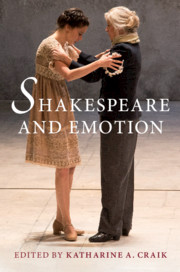Book contents
- Shakespeare and Emotion
- Shakespeare and Emotion
- Copyright page
- Contents
- Figures
- Contributors
- Acknowledgements
- Note on Text
- Introduction
- Part I Contexts
- Chapter 1 Rhetoric
- Chapter 2 Medicine
- Chapter 3 Religion
- Chapter 4 Character
- Chapter 5 Inheritance and Innovation
- Chapter 6 Communities
- Chapter 7 Audiences
- Chapter 8 Acting
- Chapter 9 Bollywood
- Chapter 10 Language
- Chapter 11 Emotional Labour
- Chapter 12 Passionate Shakespeare
- Part II Emotions
- Bibliography
- Index
Chapter 4 - Character
As You Like It, Hamlet
from Part I - Contexts
Published online by Cambridge University Press: 01 October 2020
- Shakespeare and Emotion
- Shakespeare and Emotion
- Copyright page
- Contents
- Figures
- Contributors
- Acknowledgements
- Note on Text
- Introduction
- Part I Contexts
- Chapter 1 Rhetoric
- Chapter 2 Medicine
- Chapter 3 Religion
- Chapter 4 Character
- Chapter 5 Inheritance and Innovation
- Chapter 6 Communities
- Chapter 7 Audiences
- Chapter 8 Acting
- Chapter 9 Bollywood
- Chapter 10 Language
- Chapter 11 Emotional Labour
- Chapter 12 Passionate Shakespeare
- Part II Emotions
- Bibliography
- Index
Summary
A tenet of the burgeoning history of emotions is that emotions are cultural and social practices that change over time. Emotional understandings, vocabularies and representations are neither universal nor constant, but historically contingent and in a continuing process of adaptation. In this chapter we first examine the dramatist’s tool-kit that Shakespeare found to hand in his own theatrical profession and contemporary culture for constructing dramatic ‘personations’ apparently endowed with passions, affections and feelings. We then turn, necessarily more briefly, to how understanding of links between characters and emotions changed through the eighteenth century and into the more psychologically inclined twentieth and beyond. The main reference point is As You Like It, whose very title invites an affective audience response. This play abounds with characters speaking languages of love, and also exhibits metatheatrical references illuminating process of composition. We can observe at close range his strategies of creating ‘feigned’ dramatic personages who, though ‘artificial’, convey to audiences emotional consciousness.
- Type
- Chapter
- Information
- Shakespeare and Emotion , pp. 64 - 78Publisher: Cambridge University PressPrint publication year: 2020
- 1
- Cited by

